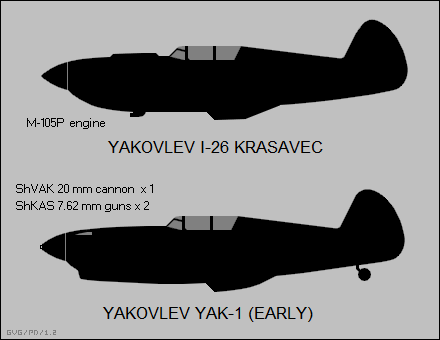no yak 1 
I'm sure we're not missing out that much by not getting Yak 1 for early war (early war = 1940-41) unless you really want a loose copy of early LaGG-3s by Yakovlev Bureau

If we do get Yak-1 for early war I think it will look like this...



* The first pre-production I-26 fighters rolled of the production lines of a Moscow plant and were passed on to a field evaluation unit. These aircraft were fully armed with the ShVAK 20 millimeter cannon and two ShKAS 7.62 millimeter machine guns. Pilots regarded the armament as too light, though Soviet aerial machine guns and cannons had rates of fire very roughly about half again greater than their Western counterparts as partial compensation. About one in five of the fighters were fitted with racks to carry six RS-82 82 millimeter rockets on underwing racks, which would be used for both air-to-ground and air-to-air combat. Although inaccurate, they would literally blow an enemy aircraft apart on a hit, and had delay fuzing that allowed them to burst inside enemy bomber formations, blasting out a cloud of shrapnel.
The fuel tanks obtained some protection against small-arms fire by being covered with four layers of coarse cord fabric, impregnated with phenol-formaldehyde resin. The cockpit was equipped with basic engine and flight instruments, plus a simple gunsight, a compass, and a clock. Radio gear was not standard at the time, but the I-26 could carry a one-channel radio. Landing lights were not fitted.
There were still various technical problems, particularly with the undercarriage and the engine, with Yakovlev and his team working on fixing them as aircraft rolled out the door of the factory. They managed to patch up the worst bugs, but only at the expense of increasing the aircraft's weight, reducing its performance. Top speed was 540 KPH (335 MPH) and range was 700 kilometers (435 miles); the speed needed to be increased, though the range was tolerable for front-line battlefield operations. Soviet industry was busy turning out other new fighters, such as the LaGG-1 and MiG-3, with bugs of their own. There was no time to wait for something better. The Soviets had to make do with what they had and try to work out the problems as they went along.
Production for the new Yak fighter ramped up only slowly. By the end of 1940, only 64 had been delivered. At this time, the type was redesignated "Yak-1" by Stalin's order.
By the time of the German invasion of the USSR on 22 June 1941, almost 400 Yak-1s had been delivered. Despite the deficiencies of the Yak-1, it was still better than the old Polikarpov fighters that equipped most other fighter units, but remained inferior to the German Bf-109F. Red planes were swept out of the sky by the Luftwaffe, with German pilots achieving a kill ratio of at least ten to one. However, few experienced Soviet pilots were lost; the bulk of the aircraft destroyed were obsolete anyway; and although the Soviets took much greater losses than the Germans, the USSR was much more able to replace them over the long run.
* Even though the Yakovlev production and design facilities were moved wholesale out of the path of the German advance to east of the Urals, production of the Yak-1 was only interrupted for a short time, a tribute to the competent planning of the move. As new Yak-1s were rolled off the production lines for immediate delivery to frontal forces, Yakovlev engineers added new features designed in response to "front-line demand" by Red pilots.
Beginning in the summer of 1941, Yak-1s were also fitted with the improved Klimov M-105PA engine, which was more reliable than the M-105P, if still not entirely satisfactory, and could operate in inverted flight and negative-gee maneuvers. A number of winterized Yak-1s, with retractable ski landing gear, white paint, and other cold-weather refinements, were produced in the winter of 1941:1942. The racks for the RS-82 rockets were eliminated from production in the spring of 1942 since they degraded the aircraft's performance. They were replaced by underwing racks for a total of two bombs of up to 100 kilograms (220 pounds) each. However, the Yak-1 simply didn't have enough horsepower to carry that kind of a load well, and in practice it was used as a fighter-bomber only in a pinch.
http://www.airvectors.net/avyak1.html